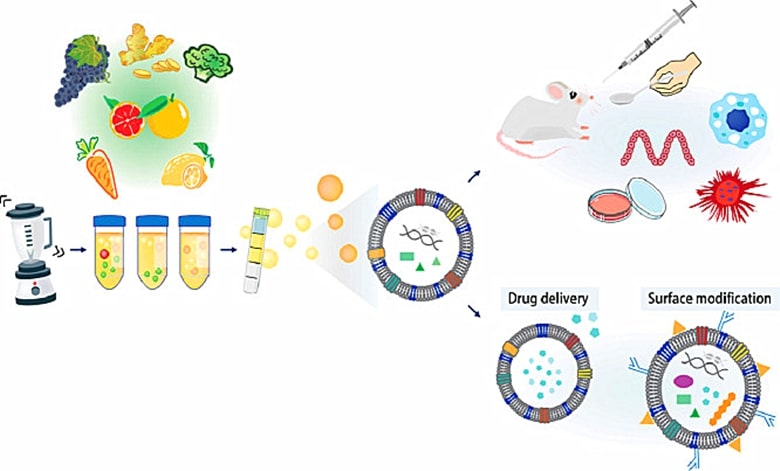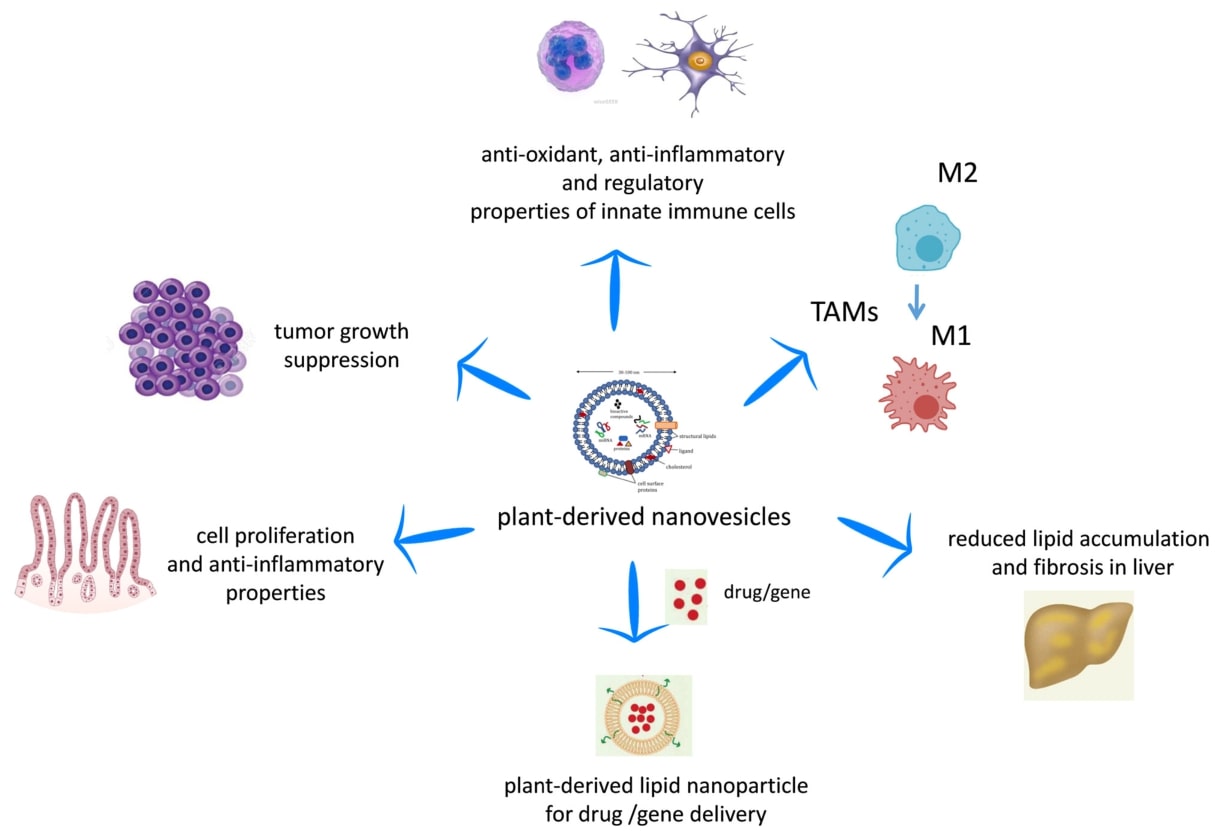Plant Exosomes
Research and functional analysis of exosomes has been extended to the field of plants, broadening new ideas about the selection and application of exosomes. Plant-derived exosome-like nanoparticles (PENs) have the advantages of being easy to prepare and less toxic, and carry similar active ingredients as the donor plant, exerting the potential to prevent and treat diseases. Creative Biolabs has accumulated research experience in a variety of projects in the preparation and application of PENs, and aims to provide customized plant exosome research services.
Overview of PENs
Unlike animal cell sources, PENs are available from a wider range of sources, including fruits, vegetables and herbs, and are prepared in a short time and with high yields. By selecting plant sources with both medicinal and edible properties, the PENs obtained not only inherit the pharmacological efficacy of the parent, but also do not cause toxic damage. Studies have shown that edible plant-derived PENs are able to tolerate the environment of intestinal fluid and gastric acid for a long time after oral administration, which is less difficult than the administration of injected animal-derived exosomes. Furthermore, as vesicle-like carriers mediating proximal and distal intercellular communication, the delivery platform of PENs co-active compounds could likewise provide an environment for slow release of drugs in human cells, enhancing the ability of active molecules to modify the fate of target cells. In conclusion, referring to the research system of animal secreted exosomes, the exploration of the development strategy and application function of PENs provides new inspiration for disease treatment.
 Fig.1 Plants secrete exosome-like nanoparticles. (Kim, 2022)
Fig.1 Plants secrete exosome-like nanoparticles. (Kim, 2022)
Strategies for the Preparation of PENs
Similar to other vesicle extraction methods, the separation of PENs is still based on differential centrifugation and sucrose density gradient centrifugation. Plant tissues are first ground and coarsely filtered, after which cellular debris is removed by low-speed centrifugation and PENs products are collected by high-speed centrifugation. PENs isolated from donors such as ginger, lemon and Arabidopsis can already be observed under electron microscopy. Sucrose introduced in ultracentrifugation is used as a protective medium to reduce agglomeration and disruption of PENs. Additional techniques such as vacuum permeation, size exclusion and microfluidics for further purification are also emerging.
It is of concern that the composition of the lipid bilayer of PENs differs from that of animal-derived exosomes. phosphatidic acid (PA), phosphatidylcholine (PC), phosphatidylethanolamine (PE), monogalactosyl diglyceride (MGDG) and digalactosyl diacylglycerol (DGDG) have been detected on the membranes of PENs, whereas the lipid membranes of animal-derived exosomes are composed of phosphatidylserine, cholesterol and ceramides, etc. The composition of lipid fractions is closely related to the uptake and function of PENs due to specific lipids that influence the tissue targeting fate of PENs. For example, the presence of PA increases the duration of sustained accumulation of PENs in the intestine, while PC may be associated with the migration of intestinal PENS to the liver. MGDG and DGDG, as glycoesters, are associated with increased stability of various lipid particles.
 Fig.2 A schematic illustration of a general method for isolating PENs. (Kim, 2022)
Fig.2 A schematic illustration of a general method for isolating PENs. (Kim, 2022)
Application of PENs
The secretion process of unconventional proteins in plants that do not pass through organelles is associated with the formation of PENs, accompanied by the delivery of miRNAs and lipids, thus regulating life activities such as development, metabolism and immune responses. Therefore, it is promising to develop the application of PENs in a variety of fields by studying functionally relevant key components and properties. For example, exosomes secreted by medicinal plants such as ginger, ginseng, honeysuckle and aloe vera have shown promising therapeutic potential in anti-tumor, regulation of intestinal flora, antioxidant and pro-repair. The killing of gastric cancer cell lines by lemon PENs may be due to the targeted stimulation of GADD45α expression in the MAPK/p53 pathway. In addition, PENs could also perform well as drug delivery platforms in terms of circulatory stability, drug slow release and biocompatibility. The synergistic effect of lemon and grapefruit-derived PENS combined with DOX and other antitumor drugs has been demonstrated. Meanwhile, PENs wrapped with molecules such as astaxanthin and retinol can overcome the challenge of easy cargo decomposition and demonstrate excellent stratum corneum penetration in skin care. In conclusion, screening available PENs and engineering them to express or enrich a given biomolecule according to specific needs is a promising strategy to enhance the efficacy of exosome-based drug adjuvants.
 Fig.3 Biological properties of PENs. (Di, 2020)
Fig.3 Biological properties of PENs. (Di, 2020)
Research on plant exosomes based platforms is still in its infancy, and the future standardized production and complete product layout is an attractive area with considerable development advantages and application potential. As a pioneer in conducting exosome research and development, Creative Biolabs can take advantage of years of research in exosome-related projects to provide cutting-edge and best-in-class plant exosome research services. Please contact us to meet your needs.
References
-
Kim, J. et al. Plant-derived exosome-like nanoparticles and their therapeutic activities. Asian J Pharm Sci. 2022, 17(1): 53-69.
-
Di, Gioia. S. et al. Biological properties and therapeutic effects of plant-derived nanovesicles. Open Med (Wars). 2020, 15(1): 1096-1122.
For Research Use Only. Cannot be used by patients.
Related Services:

 Fig.1 Plants secrete exosome-like nanoparticles. (Kim, 2022)
Fig.1 Plants secrete exosome-like nanoparticles. (Kim, 2022)
 Fig.2 A schematic illustration of a general method for isolating PENs. (Kim, 2022)
Fig.2 A schematic illustration of a general method for isolating PENs. (Kim, 2022)
 Fig.3 Biological properties of PENs. (Di, 2020)
Fig.3 Biological properties of PENs. (Di, 2020)









